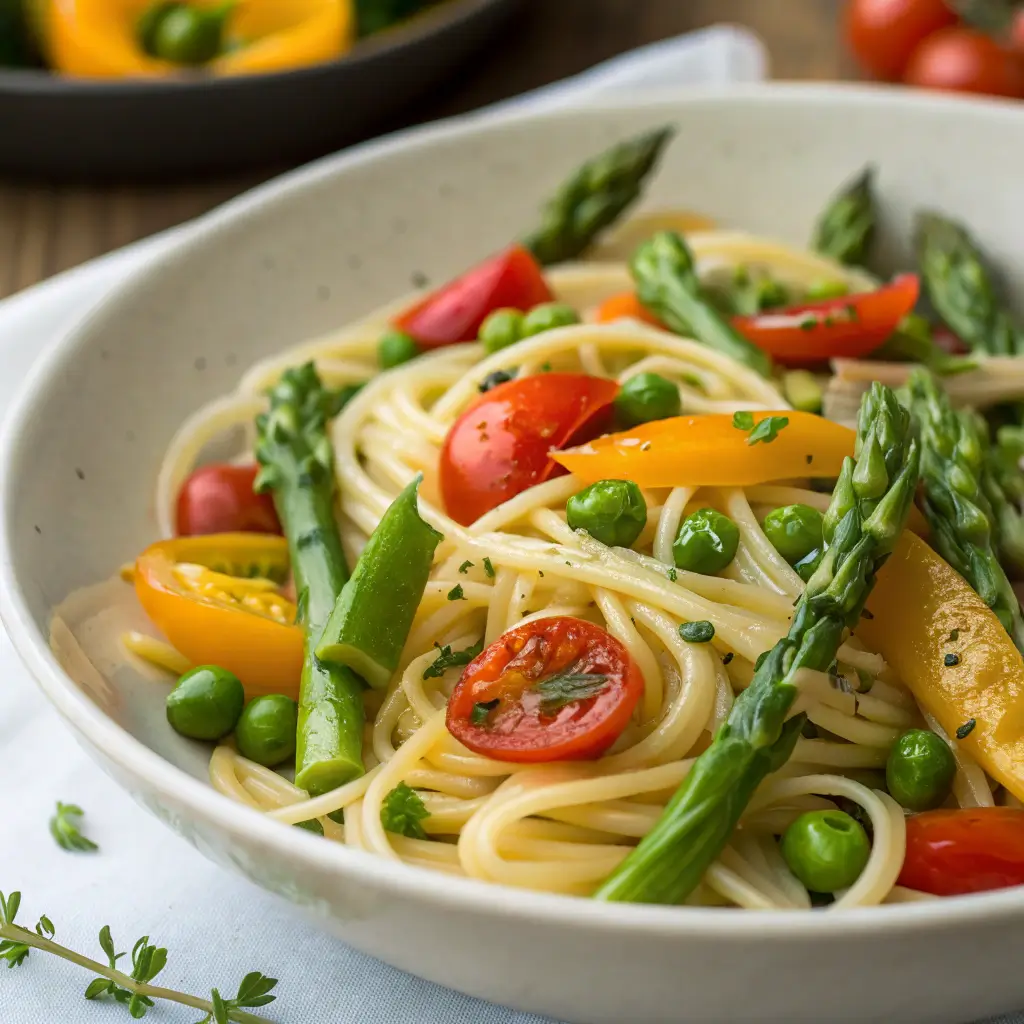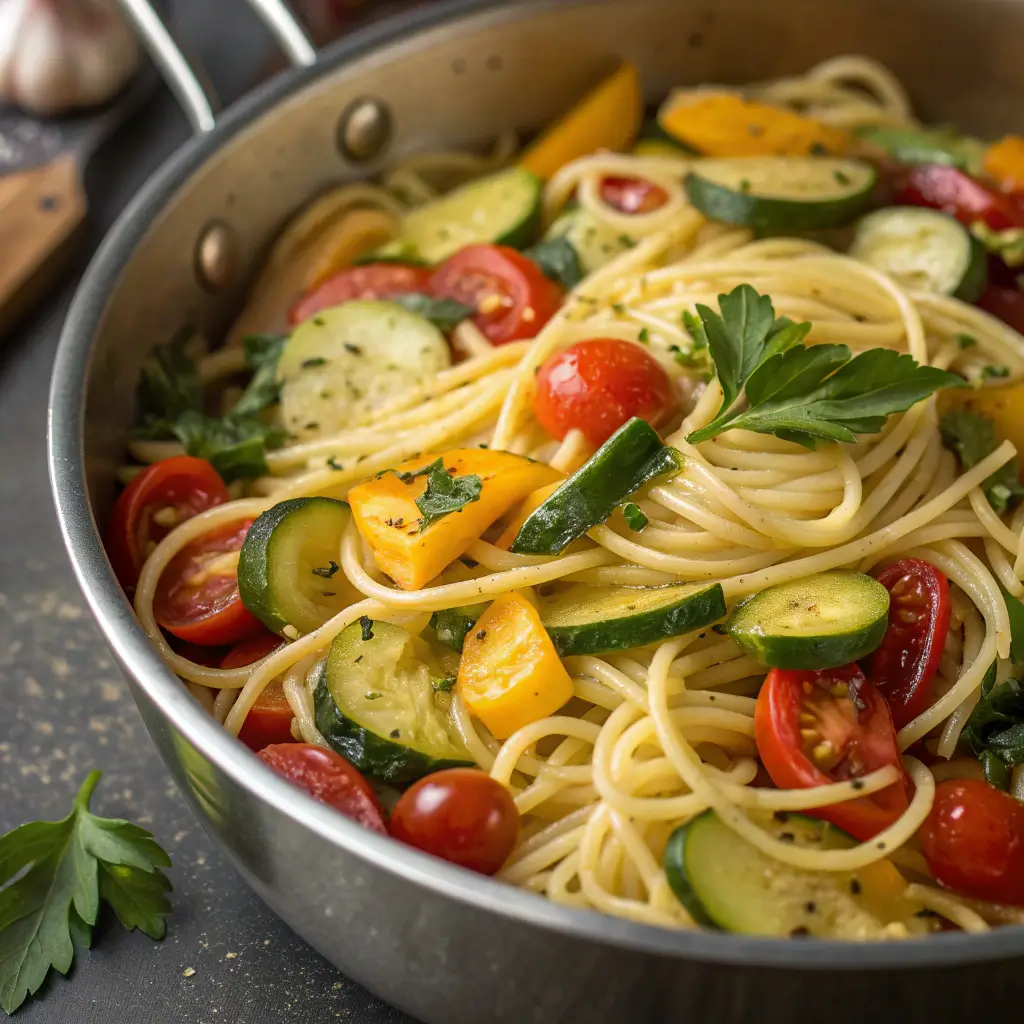Spring Vegetable Pasta Primavera: A Light and Fresh Seasonal Favorite
Introduction
When spring arrives, so does an abundance of fresh, colorful vegetables that deserve to be celebrated on the dinner table. One of the best ways to highlight seasonal produce is with a Spring Vegetable Pasta Primavera. Light yet filling, this dish combines tender pasta with vibrant vegetables and a silky sauce that ties everything together.
“Primavera” means spring in Italian, and the dish was first introduced in the United States in the 1970s as a way to showcase vegetables in a fresh, modern way. Over the years, it has become a beloved seasonal classic—perfect for weeknight dinners, family gatherings, or even elegant entertaining.
What makes this recipe special is its adaptability. You can toss in whatever spring vegetables you have on hand—think asparagus, peas, zucchini, carrots, cherry tomatoes, or bell peppers—and transform them into a dish that tastes like sunshine in a bowl.

Why You’ll Love This Pasta Primavera
- Seasonal & fresh – Uses the best spring produce at peak flavor.
- Healthy & colorful – Packed with vitamins, fiber, and antioxidants.
- Versatile – Works with any pasta and mix of veggies you prefer.
- Light but satisfying – Creamy, zesty, and comforting without feeling heavy.
- Quick & easy – Ready in under 30 minutes, perfect for busy nights.
Ingredients & Equipment
Ingredients (Serves 4–6)
For the Pasta:
- 12 oz (340 g) penne, fettuccine, or spaghetti
- 1 tablespoon olive oil
- 2 cloves garlic, minced
- 1 small onion, finely chopped
- Juice and zest of 1 lemon
- 1 cup asparagus, cut into 2-inch pieces
- 1 cup zucchini, thinly sliced into half-moons
- 1/2 cup heavy cream or half-and-half (optional for creaminess)
- 1 cup cherry tomatoes, halved
- 1 cup bell peppers (yellow or red), thinly sliced
- 1/2 cup grated Parmesan cheese
- 1 cup carrots, julienned or thinly sliced
- 1 cup peas (fresh or frozen)
- 2 tablespoons fresh basil, chopped
- 2 tablespoons fresh parsley, chopped
- Salt and freshly ground black pepper, to taste
Optional Garnishes:
- Extra Parmesan shavings
- Crushed red pepper flakes
- Extra basil leaves
Equipment
- Large pot for pasta
- Large skillet or sauté pan
- Colander
- Wooden spoon or spatula
- Zester and juicer
Step-by-Step Instructions
Step 1: Cook the Pasta
Bring a large pot of salted water to a boil. Add pasta and cook until al dente, according to package directions. Reserve 1 cup of pasta cooking water, then drain.
Step 2: Sauté Aromatics
In a large skillet, heat olive oil over medium heat. Add garlic and onion, sautéing until fragrant and translucent, about 2–3 minutes.
Step 3: Add Vegetables
Add carrots and asparagus first, since they take longer to cook. After 3–4 minutes, stir in zucchini, bell peppers, peas, and cherry tomatoes. Cook until tender-crisp, about 5 minutes.
Step 4: Create the Sauce
Reduce heat to low. Stir in cream (if using), Parmesan cheese, lemon juice, and zest. Toss to combine. Add reserved pasta water a little at a time to create a silky sauce.
Step 5: Combine Pasta and Sauce
Add drained pasta to the skillet, tossing until fully coated with sauce and mixed with vegetables. Season with salt and pepper. Stir in fresh basil and parsley just before serving.
Step 6: Garnish and Serve
Top with extra Parmesan, basil leaves, and crushed red pepper flakes for a touch of heat. Serve immediately.
Tips for the Best Pasta Primavera
- Cook vegetables in stages: Start with firm veggies (carrots, asparagus) and finish with delicate ones (peas, tomatoes) to ensure even cooking.
- Don’t overcook pasta: Keep it al dente so it doesn’t get mushy when combined with sauce.
- Balance flavors: Lemon juice brightens the dish, while Parmesan adds depth.
- Cream or no cream: Traditional versions are lighter, but a splash of cream creates a silky, restaurant-style finish.
- Save pasta water: It’s the secret to binding the sauce and helping it cling to the noodles.
Flavor Variations
- Herb-forward: Swap parsley for fresh mint or tarragon for a springy twist.
- Cheesy upgrade: Add ricotta dollops or crumbled goat cheese on top.
- Spicy version: Stir in red pepper flakes or a pinch of cayenne for heat.
- Protein boost: Add grilled chicken, shrimp, or salmon for a heartier meal.
- Vegan option: Skip cream and cheese—use olive oil and nutritional yeast instead.
Nutritional Benefits
- Asparagus: Rich in vitamin K, folate, and fiber.
- Zucchini: Low-calorie, hydrating, and full of vitamin C.
- Peas: High in plant protein and antioxidants.
- Carrots: Excellent source of beta-carotene and vitamin A.
- Tomatoes: Packed with lycopene, beneficial for heart health.
- Whole-grain pasta (if used): Adds extra fiber and nutrients.
This dish is a powerhouse of vitamins and minerals, supporting immunity, digestion, and overall health while still tasting indulgent.
Serving Ideas
- Main course: Perfect on its own as a satisfying vegetarian meal.
- With protein: Pair with grilled salmon, roasted chicken, or shrimp.
- At parties: Serve family-style in a large bowl for gatherings.
- For meal prep: Store in containers and reheat for quick lunches.
Storage & Make-Ahead Tips
- Refrigeration: Store leftovers in an airtight container for up to 3 days.
- Reheating: Warm gently on the stove with a splash of water or broth.
- Freezing: Not recommended, as vegetables may lose texture.
- Make-ahead tip: Chop vegetables in advance and store in the fridge, then cook everything fresh when ready to serve.

Frequently Asked Questions
Q: Can I make this pasta without cream?
Yes! Simply use olive oil, lemon juice, and pasta water for a lighter version.
Q: What pasta shape works best?
Penne, spaghetti, or fettuccine are classic, but any shape works well.
Q: Can I use frozen vegetables?
Yes. While fresh is best, frozen peas, carrots, and even asparagus tips can be used.
Q: Is this recipe vegetarian?
Yes. To make it vegan, skip dairy-based ingredients and use plant-based alternatives.
Why This Recipe Works
Pasta Primavera celebrates the best of spring produce in a simple, flavorful way. Each ingredient plays a role: pasta provides comfort, vegetables bring freshness, Parmesan adds richness, and lemon ties it all together. It’s versatile, adaptable, and approachable for cooks of all levels.
Conclusion
Spring Vegetable Pasta Primavera is a timeless recipe that brings color, freshness, and flavor to your table. It’s quick enough for busy weeknights, elegant enough for entertaining, and endlessly customizable. Every bite is light, bright, and brimming with seasonal goodness.
If you’re looking for a dish that perfectly captures the spirit of spring, this pasta is it. Fresh vegetables, tender pasta, and a zesty sauce make it a dish you’ll want to revisit again and again.
